You searched for: %E9%87%91%E8%9E%8D%E6%9C%BA%E6%9E%84%E7%B3%BB%E7%BB%9F%E6%BA%90%E7%A0%81%E5%BF%AB%E9%80%9F%E5%BC%80%E5%8F%91%E3%80%90TG%EF%BF%BD%EF%BF%BD%EF%BF%BD%EF%BF%BD%EF%BF%BD%EF%BF%BD%EF%BF%BD%EF%BF%BD%EF%BF%BD%40EK7676%E3%80%91%E5%B9%B3%E5%8F%B0%E5%8C%85%E7%BD%91%E6%90%AD%E5%BB%BA%E9%87%91%E8%9E%8D%E6%9C%BA%E6%9E%84%E7%B3%BB%E7%BB%9F%E6%BA%90%E7%A0%81%E5%BF%AB%E9%80%9F%E5%BC%80%E5%8F%91%E3%80%90TG%EF%BF%BD%EF%BF%BD%EF%BF%BD%EF%BF%BD%EF%BF%BD%EF%BF%BD%EF%BF%BD%EF%BF%BD%EF%BF%BD%40EK7676%E3%80%91%E5%B9%B3%E5%8F%B0%E5%8C%85%E7%BD%91%E6%90%AD%E5%BB%BA5xkK5bydcV
<< Previous | Displaying results 151-175 of 215 for "%E9%87%91%E8%9E%8D%E6%9C%BA%E6%9E%84%E7%B3%BB%E7%BB%9F%E6%BA%90%E7%A0%81%E5%BF%AB%E9%80%9F%E5%BC%80%E5%8F%91%E3%80%90TG%EF%BF%BD%EF%BF%BD%EF%BF%BD%EF%BF%BD%EF%BF%BD%EF%BF%BD%EF%BF%BD%EF%BF%BD%EF%BF%BD%40EK7676%E3%80%91%E5%B9%B3%E5%8F%B0%E5%8C%85%E7%BD%91%E6%90%AD%E5%BB%BA%E9%87%91%E8%9E%8D%E6%9C%BA%E6%9E%84%E7%B3%BB%E7%BB%9F%E6%BA%90%E7%A0%81%E5%BF%AB%E9%80%9F%E5%BC%80%E5%8F%91%E3%80%90TG%EF%BF%BD%EF%BF%BD%EF%BF%BD%EF%BF%BD%EF%BF%BD%EF%BF%BD%EF%BF%BD%EF%BF%BD%EF%BF%BD%40EK7676%E3%80%91%E5%B9%B3%E5%8F%B0%E5%8C%85%E7%BD%91%E6%90%AD%E5%BB%BA5xkK5bydcV" | Next >>
-
Fighting in the Philippines
FilmJapanese forces took the Philippine islands between December 1941 and May 1942. After US naval victory in the Battle of Midway (June 1942), Allied forces slowly gained naval and air supremacy in the Pacific war. In October 1944, US forces began the liberation of the Philippines. The campaign on Luzon, largest and most northern of the islands, began in December 1944. This battle footage shows many Japanese soldiers being taken as prisoners of war.
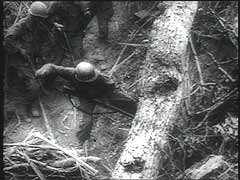
-
Coining a Word and Championing a Cause: The Story of Raphael Lemkin
ArticlePolish-Jewish lawyer Raphael Lemkin introduced the word genocide in 1944 and lobbied tirelessly for its addition as a crime in international law.
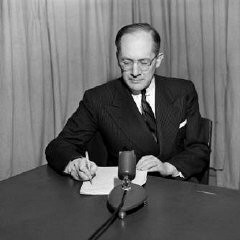
-
Righteous Among the Nations
ArticleRighteous Among the Nations are non-Jewish individuals honored by Yad Vashem, Israel's Holocaust memorial, for risking their lives to aid Jews during the Holocaust.

-
UN Convention on the Prevention and Punishment of Genocide
Timeline EventJanuary 12, 1951. On this date, the United Nations Convention on the Prevention and Punishment of Genocide entered into force.
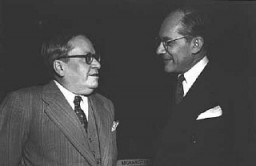
-
Raphael Lemkin Dies
Timeline EventAugust 28, 1959. On this date, Raphael Lemkin died. He coined the term "genocide" and worked tirelessly for the term to become international law.

-
Establishment of Dachau Camp
Timeline EventMarch 22, 1933. On this date, the SS established the Dachau concentration camp in Germany.
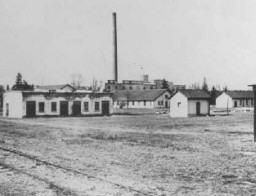
-
Coenraad Rood
ID CardCoenraad was born to a Jewish family in Amsterdam that traced its roots in the Netherlands back to the 17th century. After graduating from public school, Coenraad went on to train as a pastry maker at a trade school. But after completing his training at the age of 13, he decided for health reasons to change professions, and he began to study tailoring. 1933-39: Coenraad finished apprenticing as a tailor in 1937 when he was 20. Then he spent a year working as a nurse in a Jewish home for the permanently…
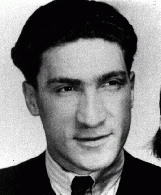
-
Theresienstadt: "Retirement Settlement" for German and Austrian Jews
ArticleIn 1942, German authorities began to deport German and Austrian Jews to Theresienstadt. Learn about the administration of the camp-ghetto and Jews’ experiences.

-
Brandenburg T4 Facility
ArticleBrandenburg was one of six killing centers the Nazis established to murder patients with disabilities under the so-called "euthanasia" program.
-
Mina Beker
ID CardMina, born Mina Friedman, was the youngest of four daughters born to a Jewish family in the Lithuanian town of Jonava. At the age of 18, Mina married Osser Beker, a lumber dealer. The couple settled in Jonava where Mina worked as a seamstress. The Bekers had two sons and two daughters, but their oldest son died in a childhood accident. 1933-39: Mina's son Abe attended a Jewish religious school in Jonava. But since Mina had received an extensive Jewish education, she decided to teach her daughters at home.…

-
Judith Beker
ID CardJudith was one of three children born to a Yiddish-speaking Jewish family living on a farm near the Lithuanian town of Jonava. Judith's mother had an extensive Jewish education and taught her daughters at home. Her son, Abe, attended a Jewish religious school in Jonava. Judith's father worked in the logging industry. 1933-39: In the fall of 1938, six months after her father died, Judith and her mother moved to Kovno, the capital of Lithuania. She was 9 years old. Kovno at that time had a large Jewish…

-
Abraham Malnik describes massacre in Kovno's Ninth Fort, near the Kovno ghetto
Oral HistoryAbraham came from a wealthy family that was ordered into the Kovno ghetto after the Germans occupied Lithuania in 1941. Abraham's mother urged his father to flee, but he returned for them. Begging for mercy, he was able to save them from a massacre in the Ninth Fort, one of several forts around Kovno. Abraham and his father survived internment in five camps before they were finally liberated in the Theresienstadt ghetto. Abe's mother perished at the Stutthof camp.
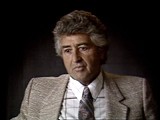
-
Robert Wagemann describes fleeing from a clinic where, his mother feared, he was to be put to death by euthanasia
Oral HistoryRobert and his family were Jehovah's Witnesses. The Nazis regarded Jehovah's Witnesses as enemies of the state for their refusal to take an oath of loyalty to Adolf Hitler, or to serve in the German army. Robert's family continued its religious activities despite Nazi persecution. Shortly before Robert's birth, his mother was imprisoned briefly for distributing religious materials. Robert's hip was injured during delivery, leaving him with a disability. When Robert was five years, he was ordered to report…

-
Eleanor Roosevelt
ArticleEleanor Roosevelt, longest serving First Lady in US history, used her social and political influence to intervene on behalf of refugees before and during WWII.
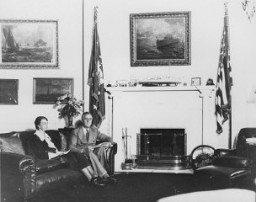
-
Life After the Holocaust: Regina Gelb
ArticleAfter WWII and the fall of the Nazi regime, Holocaust survivors faced the daunting task of rebuilding their lives. Listen to Regina Gelb's story.
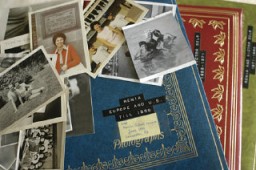
-
The Riegner Telegram
ArticleThe Riegner telegram detailed the Nazi plan to systematically murder European Jews. It was sent to the British and American governments in August 1942.
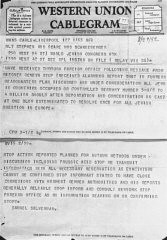
-
Henny Schermann
ID CardHenny's parents met in Germany soon after her father emigrated from the Russian Empire. Henny was the first of the Jewish couple's three children. The family lived in Frankfurt am Main, an important center of commerce, banking, industry and the arts. 1933-39: After the Nazis came to power, they began to persecute Jews, Roma (Gypsies), men accused of homosexuality, people with disabilities, and political opponents. In 1938, as one way of identifying Jews, a Nazi ordinance decreed that "Sara" was to be…

-
The Nuremberg Race Laws
ArticleThe Nazi regime’s Nuremberg Race Laws of September 1935 made Jews legally different from their non-Jewish neighbors. The laws were the foundation for future antisemitic measures .

-
Japan attacks Pearl Harbor
FilmWhile Japanese diplomats in Washington, DC, negotiated with Secretary of State Cordell Hull, Japanese planes bombed the naval base at Pearl Harbor. American outrage at the surprise attack overcame isolationist sentiment and the United States declared war on Japan the following day.
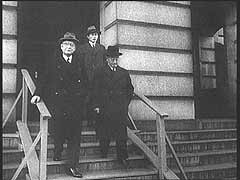
-
US Quakers aid children in defeated France
FilmDuring World War II , the American Friends Service Committee, a Quaker relief organization, provided food, shelter, and other aid to thousands of Jewish refugees—especially Jewish children—in France. The Quakers were active throughout France, even in areas occupied by German forces. In this footage, Quaker relief workers feed children at one of the Quaker-established schools in Marseille in the unoccupied southern zone of France.
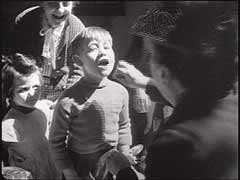
-
Theresienstadt: Establishment
ArticleLearn about the establishment of the Theresienstadt camp/ghetto, which served multiple purposes from 1941-45 and had an important propaganda function for the Germans.

-
The Survivors
ArticleSurvivors faced huge obstacles in rebuilding their lives after the devastation of the Holocaust years. Learn about some of the challenges they faced.

-
Air war in Flanders: Western Campaign
FilmThe Junkers (Ju) 87, known as the "Stuka," spearheaded the Blitzkrieg ("lightning war") attacks that were decisive in the western campaign in 1940. Stuka dive-bombers closely supported German forces on the ground. They destroyed enemy strong points, aircraft, and airfields, and spread panic in rear areas. Although slow and easily shot down by Allied fighters, the Stukas proved devastatingly effective in the German invasions of Poland and western Europe, where Germany enjoyed air superiority. Stuka…

-
Szlamach Radoszynski
ID CardSzlamach was one of six children born to Yiddish-speaking, religious Jewish parents. Szlamach's father was a peddler, and the Radoszynski family lived in a modest apartment in Warsaw's Praga section on the east bank of the Vistula River. After completing his schooling at the age of 16, Szlamach apprenticed to become a furrier. 1933-39: During the 1930s Szlamach owned a fur business. Despite the Depression, he was hoping the economy would turn around so that he could make enough money to move into his own…

-
Isachar Herszenhorn (Irving Horn)
ID CardIsachar was born to a Jewish family in the Polish city of Radom, approximately 75 miles south of Warsaw. The city was the center of Poland's leather-tanning industry. Isachar's father worked as a salesman for a nearby tanning factory. His father was a successful salesman and the family lived comfortably. 1933-39: During registration for Isachar's first-grade class in 1934, a Jewish boy was pushed down the stairs. When his mother confronted the principal about the incident, all he said was that the boy had…

